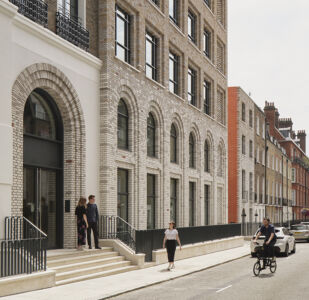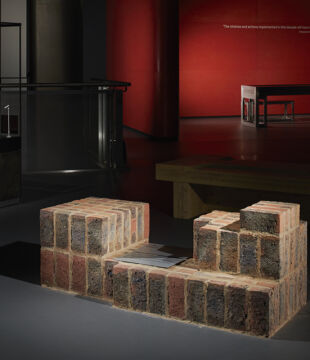
Details
Location: London
Brick Manufacturers: Bulmer Brick & Tile Co Ltd / Michelmersh Brick Holdings PLC / Wienerberger Limited
Brick Names: Red Rubber Metric / Charnwood Cathedral Grey / Smeed Dean London Stock
Architect: Fletcher Priest Architects
Brickwork Contractors: Grangewood Brickwork Services Ltd / Techrete UK Ltd / JustFacades
About the project
The Project
Marylebone Place is the thoughtful reinvention of a 1930s neo-Georgian office building, formerly known as Marylebone House, located on one of London’s most prominent thoroughfares. Completed in 2023, the redevelopment, led by Fletcher Priest Architects for Beltane Asset Management, successfully integrated a contemporary workplace into a predominantly residential conservation area.
Clay brick played a defining role in both the restoration and expansion of Marylebone Place. Central to the project was the decision to retain and adapt much of the original 1938 office building designed by the prolific architect Stanley Gordon Jeeves. Around 85% of the structure was preserved, aligning with circular economy principles and significantly reducing embodied carbon.
The original façade, composed of traditional red and yellow bricks, was meticulously cleaned and restored. A1960s curtain-wall addition to the rear was reimagined using a precast brick façade system, fabricated by Techcrete at their factory in Brigg, integrating a unique colour gradient composed of seven clay brick tones. These were carefully selected to echo the varied brick palette of the surrounding Marylebone Conservation Area. The Smeed Dean London Stock bricks reflect the classic London stock of the adjacent Georgian terraces, and the Bulmer Red Rubbers match the facing bricks of nearby Bryanston Mansions. The gradient, transitioning from light at the base to darker hues at the top, was achieved through advanced generative design techniques, with each brick type catalogued and located for off-site assembly. The precast panel movement joints were designed with a keyed brick profile to conceal movement joints. This prefabricated approach allowed for an efficient and high-quality on-site assembly, with the clay bricks adding durability, low maintenance and contextual richness.
The newly constructed mews building, a standout feature of the scheme, is constructed in glulam and cross-laminated timber, and clad with a vivid orange glazed brickwork. Manufactured from natural volcanic lava stone and glazed in France using traditional firing techniques, the bold colour and geometry reference the rich industrial heritage of Marylebone’s railway architecture. The distinctive brickwork provides the new building with a unique identity that is visually tied to its surroundings. Distinctive toothed corners pay homage to the 20th century Swedish architect Sigurd Lewerentz, whose individual mastery with the brick illustrated its versatility and expressiveness. The book-end elevations that front the Georgian terraces of Knox Street and Wyndham Street are faced in traditionally laid brickwork, replicating the colour gradient of the precast brickwork panels and maintaining a crafted, human-scale.
Brick detailing throughout the development is handled with great sensitivity, with arched window openings, layered brick patterns and deep reveals that provide visual depth and shadow This reinforces the architectural language of the Georgian streetscape. The character of the brick façades also appears in the refined and welcoming interior spaces, for a holistic tenant experience.
Marylebone Place exemplifies the role of clay brick in contemporary commercial architecture, adaptable, expressive, and rooted in tradition. It is both a sustainable intervention and a confident addition to its historic urban fabric, made possible by the enduring quality and craft of clay brick.
Sponsored by Forterra

Wherever you are in Britain, you won’t be far from a building with a Forterra brick, block or bespoke clay or concrete product somewhere in its fabric.
Our history of manufacturing building products began in the 19th century; we kept Britain building right through the 20th century; and we continue to be at the forefront of building innovation in the 21st century so you, and future generations, can continue to build history.


















